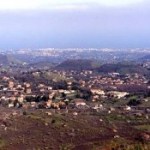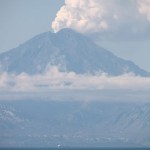Galeras
Sorry about the lack of posts - I've been not only frantically prepping for class and my Eyja talk, but also I'm somewhat under the weather with an ill-timed sickness, so even though there is stuff to talk about, I haven't really had time/wherewithal to deal with it.
However, expect big things from Eruptions next week!
Drawing of a ship washed inland by the tsunami generated by the August 27, 1883 eruption of Krakatau.
I'll throw a few quick links:
The alert status at Galeras has been dropped back down to "orange" after the non-explosive eruption earlier this week. However, INGEOMINAS warns…
Today was a doubleheader for volcanic eruptions in the news:
Today's explosive eruption from Mt. Etna. Image courtesy of the INGV.
As I briefly mentioned earlier, Galeras in Colombia had an "atypical" eruption - apparently meaning it was non-explosive - that has prompted evacuations and a change in the alert status to "Red" for the volcano. Various news sources don't have a lot of new information yet, but you can check on the report on the INGEOMINAS page (spanish) - and they have links to some of the Galeras news (audio, spanish) from their main page. Some of the latest reports from…
An undated photo of the crater at Galeras.
I am literally out the door, so I will fill this article a little more after my prior academic obligations, but there are reports of an eruption at Galeras in Colombia overnight. 8,000 people living near the volcano have been evacuated as INGEOMINAS moved the alert status at the volcano to "Red". Not much out there on the details of the eruption beyond this intriguing statement:
Diego Gomez from the Pasto Observatory of Vulcanology and Seismology said that due to the atypical, non-explosive eruption, another eruption is imminent.
Galeras the most…
The final part of Etna Week, brought to us by guest blogger Dr. Boris Behncke. Check out Part 1 and Part 2 as well!
Etna Volcanic hazards
By guest blogger Dr. Boris Behncke.
Etna is one of the most active volcanoes on Earth, and a population of nearly one million people dwell on its flanks, many in areas that have been repeatedly invaded by lava flows during the historical period. A few villages have been constructed very close to the vents of eruptions only a few hundred years old.
Top: Residential areas surrounding numerous pyroclastic cones on the lower southeast flank of Etna, seen from…
Sally Sennert from the Smithsonian Institution sent me an email to say that this week's USGS/Smithsonian Institute Weekly Volcanic Report will be delayed due to the inclement weather in the Washington DC area. She can't connect with the server, so the report can't be updated on the Smithsonian website ... so here it is! Look for it to show up on the Smithsonian site with all the bells and whistles as soon as DC thaws out.
And a big thanks to Sally for sending me the Report to post.
***PLEASE NOTE: Website posting of the SI/USGS Weekly Volcanic Activity Report for 3-9 February 2010 will be…
A pile of news for the new week!
The glow of new lava flows from Nyamuragira in the Congo, taken from the Virunga Park Headquarters, January 2, 2010.
MayonPHIVOLCS may lower the alert status at Mayon to Level 2 after almost a week of lower seismicity and no ash explosions since December 29th. Schools that were being used as evacuation centers were also returned to teachers and students for the start of classes after the Christmas holiday. However, the Albay provincial government is now considering a plan to permanently move everyone who lives within the 6-km danger zone around Mayon, even if…
Undated image of the crater at Galeras in Colombia.
UPDATE 1/3/09 Midnight: I'm bumping this up from the comments, but INGEOMINAS posted some stunning webcam video of the eruption as it happened. Wow is all I say. {Hat tip to Doug C. for the video}
A quick note tonight: Eruptions reader Chance Metz alerted me to an impressive eruption of Galeras in Colombia tonight. The VAAC warning issued for the eruption suggests a 40,000 foot / 12 km ash plume and the reports seem to back it up, with the Red Cross reporting "very high ash cloud". No injuries/fatalities have been reported, but Galeras is…
Here it is, my attempt to recap a year's worth of volcanic events. By no means is this supposed to capture every event, but rather the highlight/lowlights and what most captivated me during 2009. I'll be announcing the winner of the 2009 Pliny for Volcanic Event of the Year tomorrow.
Waimangu Geothermal Valley in New Zealand, taken in January 2009 by Erik Klemetti.
January
The year started out with a trip to New Zealand (well, for me at least) and vistas of the Waimangu Valley, formed in the 1886 eruption of Tarawera on the North Island. We were also still thinking about the late 2008…
Back from Iowa, time for some volcano news. Look for the answers to your questions for Dr. Boris Behncke to get posted later this week.
(And thanks for all the comments and kind words in the Open Thread. I'll start thinking about how to implement a lot of these in the next few weeks).
Undated photo of Volcan Galeras in Colombia.
Galeras stopped traffic near Pasto, Colombia and prompted the evacuation of 1,000 people over the weekend when it erupted. The volcano apparently produced ash that covered towns near the volcano, including Pashto, and the highway connected that town with Pasto was…
All the news to start the week:
Galeras with a grey ash-and-steam plume behind Pasto, Colombia.
Well, after my article on Friday about Colombian volcanoes, Galeras must have decided it was left out. The volcano has been placed back at alert level Orange/II (eruption in days to weeks). An increase in seismicity and sulfur dioxide emissions (in spanish) prompted INGEOMINAS to put Galeras back on higher alert, but now the country has two volcanoes (Galeras and Huila) that could be erupting in the near future.
Back in the Philippines, there is new evidence that Mayon has a new dome forming at the…
Somehow I missed a week of the SI/USGS Weekly Volcano Activity Reports and almost missed another. Here is this week's update!
Highlights (not including Chaiten, Soufriere Hills or Cleveland) include:
The alert level at Galeras in Colombia was raised to Red after an explosion on September 30 and returned to orange ... and then yellow ... after activity tapered.
Sakurajima in Japan produced 1.8-4.3 km / 6,000-14,000-tall ash-and-steam plumes, along with incandescent tephra that was thrown almost two kilometers from the vent.
Multiple steam-and-ash plumes reached 4.3 km / 14,000 feet at Langila…
Your weekly dose of volcano news brought you by the Smithsonian Institute GVP and the USGS.
This week's highlights (not counting Sarychev Peak and Turrialba) include:
13,000 foot / 4 km ash plumes from Rinjani in Indonesia. This is part of the continuing eruption there.
The alert level was lowered at Galeras, Colombia to "Orange" after intense eruptions last week.
The current lava dome at Redoubt is 1 km long, 460 m wide, and 200 m high according to the latest images from the Alaskan volcano.
18,000-23,000 foot / 4.8-7.7 km ash plumes from Shiveluch in Kamchatka, along with thermal anomalies…
Here's the latest news from the USGS and SI Global Volcanism Program. It might not record every little volcanic noise in the world each week, but nothing like getting all the major volcanic events summarized on a weekly basis.
Highlights this week (not including Nyiragongo, Redoubt and Galeras):
The eruption at Rinjani in Indonesia continues, with elevated seismicity and 300-600 meter plumes.
Sporadic strombolian eruptions from the Crater C at Arenal, Costa Rica (since late April)
High seismicity, 100 meter domes and continued dome collapses continue at the two domes growing at Chaiten, Chile…
Redoubt emitting a large steam plume in April 2009. Image courtesy of Calvin Hall.
A few snippets from the world of volcanoes:
The current eruptive cycle at Galeras continues to go strong. Officials with INGEOMINAS, the Colombian Geology Survey, believe the volcano will erupt again in the next few "days to weeks". The volcano last erupted a few weeks ago (in spanish) and caused quite a bit of panic in the city of Pasto at the foot of the volcano. An Orange Alert has been issued (in spanish) for the volcano.
Another volcano have is on the verge of a larger eruption is Nyiragongo in the DR of…
All the eruptions fit to print from the Smithsonsian/USGS GVP Weekly Report.
A few highlights (not including Redoubt, Rinjani and Slamet):
Multiple ash plumes from Galeras (Colombia), some producing noticeable ash fall up to 35 km from the vent.
The Alert Level at Anak Krakatau, Indonesia was raised to 3 (out of 4) after a sharp increase in the number of explosions.
The Alert Level at Cleveland in Alaska was lowered from Yellow to "Unassigned" (no Green for Cleveland as there is no real-time seismic network for the volcano, thus no "background levels" to compare.)
Ebeko in Russia continues to…
The weekly USGS/SI roundup is out. Highlights (beyond Slamet) include:
Explosions (some heard 25 km away) and incandescent blocks that started fires at Galeras, Colombia.
Ash and tephra being thrown tens of meters into the air and a 4-m tall spatter cone being built at Pacaya, Guatemala
Also in Guatemala, Santa Maria's Santiaguito dome produced ash plumes and explosions.
Steam, ash and sulfur odors from the continuing eruption at Redoubt, Alaska.
Increased seismicity, steam and ash plumes along with a thermal anomaly at El Reventador in Ecuador
Your weekly dose of volcanic activity. As a sidenote, you can now get placemarks for the weekly activity report via Google Earth. Select "Google Earth Placemarks" from the SI / USGS Weekly Volcanic Activity Report page.
Highlights of this week's report:
New explosions at Ebeko. See my article today for more details.
More evidence of increased activity at Nyamuragira and Nyiragongo, Congo. One interesting note is that scientists from the Goma Volcano Observatory noted that earthquake swarms usually precede eruption by 3-5 months.
I've seen very little news about this, but Pacaya in Guatemala…
Ulawun Volcano, Papau New Guinea, one of the "Decade Volcanoes"
There was some discussion earlier about the so-called "Decade Volcanoes", so I thought I'd elaborate a bit on them (doubly so in light of certain other lists.) These volcanoes are defined by IAVCEI - the International Association of Volcanology and the Chemistry of the Earth's Interior - and are part of a program whose aim is
"to direct attention to a small number of selected, active volcanoes world-wide and to encourage the establishment of a range of research and public-awareness activities aimed at enhancing an understanding…
Hunga Tonga Hunga Ha'apai, taken in late March 2009
Redoubt did the tried-and-true American trick of shoving news of volcanoes in other parts of the world off the news pages, but shockingly, these international volcanoes continued to erupt. Remember that volcano in Tonga? Hunga Tonga Hunga Ha'aapi? Still erupting, weeks after the volcano was first spotted. The volcano is still disrupting air traffic in and out of Tonga, which is now even affecting the economy of the islands. Now, the problem is that tourists are creeping ever closer to the emerging volcanic island. The thing about visiting…
Its been a busy week for volcanoes between the headline capturing Tongan and Alaska eruptions. Catch up on what you might have missed with the latest SI/USGS Weekly Volcano Report (for 3/18-3/24). Highlights (beyond Hunga Tonga Hunga Ha'apai and Redoubt) include:
Galeras, Colombia has settled down a bit
More block-and-ash flows from the two dome complexes growing at Chaiten, Chile
Strombolian eruptions at Mt. Etna, Italy
Plumes of steam and minor ash were reported from Popocatépetl, Mexico
A small lahar was seen at Tungurahua, Ecuador
Ash plumes and incandescent tephra explosions were…

